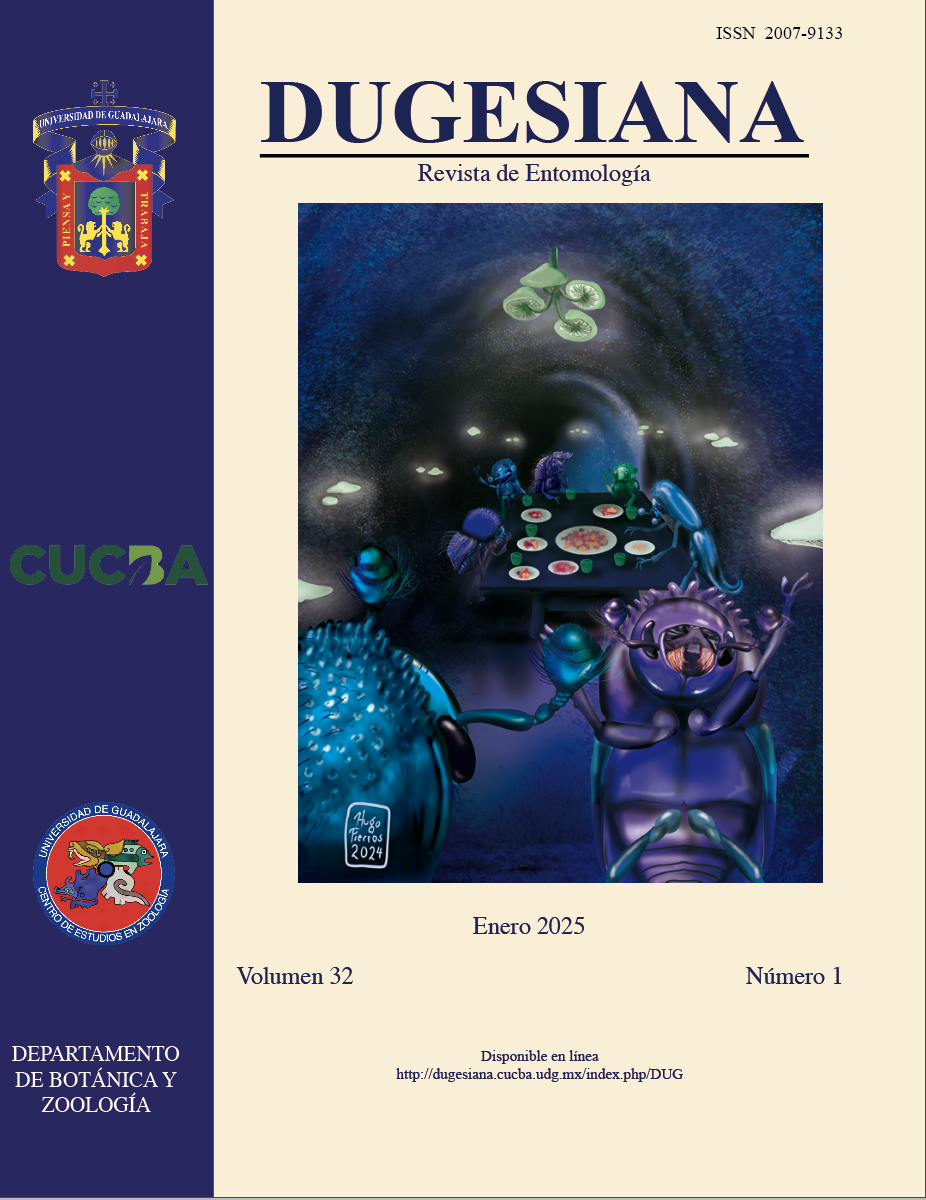A new and distinctive species of Ceratina Latreille (Hymenoptera: Apidae) from Veracruz, Mexico
DOI:
https://doi.org/10.32870/dugesiana.v32i1.7352Keywords:
Calloceratina, Cloudforest, Pollination, Small carpenter beesAbstract
Ceratina Latreille is a cosmopolitan genus with around 380 described species, typically small in size and exhibiting primitive social structures; their habit of nesting in dry plant stems has earned them the common name of small carpenter bees. This work presents an addition to the diversity of the genus in Mexico, with the description of Ceratina valenzuelai sp. nov. from the cloud forest in centralVeracruz State. Only males are known, which are polymorphic, with some macrocephalic individuals, a rare trait among the New World Ceratina. Comments on its biology and taxonomic placement within the subgenus Ceratina (Calloceratina) are also included.References
Ayala, R., T. L. Griswold y D. Yanega. 1996. Apoidea (Hymenoptera). (pp. 423-464). En: Llorente J., García-Aldrete A. N., y González Soriano E. (Eds.). Biodiversidad,taxonomía y biogeografía de artrópodos de México: Hacia una síntesis de su conocimiento I. Universidad Nacional Autónoma de México. Instituto de Biología, México, DF.
Flórez-Gómez, N., R. Ayala, I. Hinojosa-Díaz, and J. J. Morrone. 2022. The neotropical species of small carpenter bees of the subgenus Ceratina (Zadontomerus) Ashmead, 1899 (Hymenoptera: Apidae). Zootaxa, 5214(2): 189-223.
Friese, H. 1925. Neue neotropische Bienenarten, zugleich II. Nachtrag zur Bienenfauna von Costa Rica (Hymenoptera). Stettiner entomologische Zeitung, 36(2):1-141.
Gonzalez, V. H., E. Moreno, and M. H. Richards. 2004. Nesting biology of a neotropical bee, Ceratina mexicana currani Schwarz (Hymenoptera: Apidae: Xylocopinae). Journal of the Kansas Entomological Society, 77(1): 58-60.
Houston, T. F., and G. V. Maynard. 2012. An unusual new paracolletine bee, Leioproctus (Ottocolletes) muelleri subgen. and sp. nov.(Hymenoptera: Colletidae): with notes on nesting biology and in-burrow nest guarding by macrocephalic males. Australian Journal of Entomology, 51(4): 248-257.
Kukuk, P. F., and M. Schwarz. 1988. Macrocephalic male bees as functional reproductives and probable guards. Pan-Pacific Entomologist, 64: 131-137.
Mahlmann, T., F. F. de Oliveira, and M. L. de Oliveira. 2023. Taxonomy of South American species of Ceratina (Calloceratina) Cockerell, 1924 with comments on new species-groups proposed for this subgenus (Apidae:Xylocopinae). EntomoBrasilis, 16(e1062): 1-14.
Michener, C. D. 2007. The Bees of the World. Johns Hopkins University Press, Baltimore.
Mikát, M., Matoušková, E., and Straka, J. 2021. Nesting of Ceratina nigrolabiata, a biparental bee. Scientific Reports, 11(5026): 1-13.
Moure, J. S. 2007. Xylocopini Latreille, 1802. (pp. 637-674). In: Moure, J. S., D. Urban, G. A. R. Melo (Eds.) Catalogue of Bees (Hymenoptera, Apoidea) in the Neotropical Region. Sociedade Brasileira de Entomologia, Curitiba.
Oliveira, F. F. de, L. R. de Sousa Silva, F. C. V. Zanella, C. T. Garcia, H. L. Pereira, C. Quaglierini, and C. M. Pigozzo. 2020. A new species of Ceratina (Ceratinula) Moure, 1941, with notes on the taxonomy and distribution of Ceratina (Ceratinula) manni Cockerell, 1912, and an identification key for species of this subgenus known from Brazil (Hymenoptera, Apidae, Ceratinini). ZooKeys, (1006): 137-165.
Oppenheimer, R. L., and S. M. Rehan. 2021. Inclusive fitness of male and facultatively social female nesting behavior in the socially polymorphic bee, Ceratina australensis (Hymenoptera: Xylocopinae). Annals of the Entomological Society of America, 114(5): 627-636.
Rehan, S. M., and M. H. Richards. 2010. Nesting biology and subsociality in Ceratina calcarata (Hymenoptera:Apidae). The Canadian Entomologist, 142(1): 65-74.
Rehan, S. M., T. W. Chapman, A. I. Craigie, M. H. Richards, S. J. Cooper, and M. P. Schwarz. 2010. Molecular phylogeny of the small carpenter bees (Hymenoptera: Apidae: Ceratinini) indicates early and rapid global dispersal. Molecular Phylogenetics and Evolution, 55(3):1042-1054.
Sless, T. J., M. G. Branstetter, M. Mikát, K. A. Odanaka, K. B. Tobin, and S. M. Rehan. 2024. Phylogenomics and biogeography of the small carpenter bees (Apidae:Xylocopinae: Ceratina). Molecular Phylogenetics and Evolution, 198(108133): 1-9.
Published
Issue
Section
License
1. Proposed policy for open access journals
Those authors who have publications with this journal, accept the following terms:
- The authors will retain their copyright and will guarantee to the journal the right of first publication of their work, which will be simultaneously subject to the Creative Commons Recognition License, which allows third parties to share the work whenever their author is indicated and His first publication is this journal.
- Authors may adopt other non-exclusive license agreements to distribute the version of the published work (eg to be deposited in an institutional telematic file or published in a monographic volume) provided the initial publication is indicated in this journal .
Authors are encouraged and encouraged to disseminate their work through the Internet (eg in institutional telematic files or on their web page) before and during the sending process, which can produce interesting exchanges and increase appointments Of the published work. (See The effect of open access).
2. Proposed policy for journals that offer open deferred access
Those authors who have publications with this journal, accept the following terms:
- The authors will retain their copyrights and will guarantee to the journal the right of first publication of their work [SPECIFY PERIOD OF TIME], which will be simultaneously subject to the Creative Commons Recognition License that allows third parties to share the work always That its author and his first publication be indicated this journal.
- Authors may adopt other non-exclusive license agreements to distribute the version of the published work (eg to be deposited in an institutional telematic file or published in a monographic volume) provided the initial publication is indicated in this journal .
- Authors are encouraged and encouraged to disseminate their work through the Internet (eg in institutional telematic files or on their web page) before and during the sending process, which can produce interesting exchanges and increase appointments Of the published work. (See The effect of open access).




